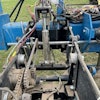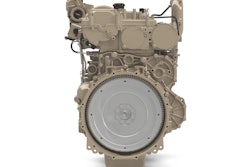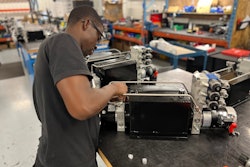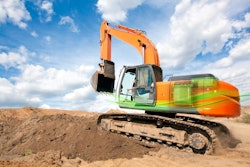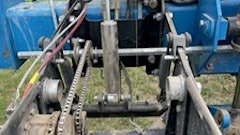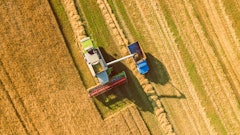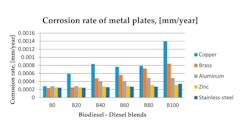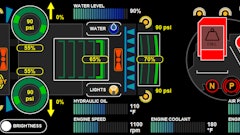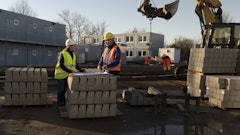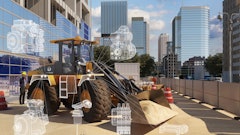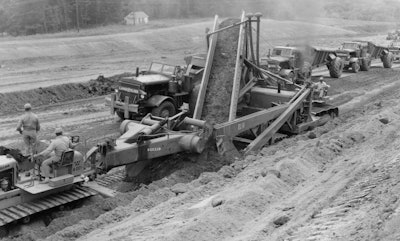
In their heyday, elevating graders were quite an efficient way of loading bank material into wagons. But as hauler size began to increase significantly with Euclid’s development of modern bottom dump trucks in the mid 1930s, these machines proved to be the weak link in their use.
To solve the problem, Euclid began developing the first traveling belt loader in the late 1930s. Introduced in 1944 and dubbed the BV, or BladeVeyor, which was a much larger, more powerful and more robust machine than what it replaced. The flow of material was more efficient; rather than forcing material to move at a right angle, the conveyor elevated it from the cutting blade at one corner to the discharge at the opposite corner, resulting in a narrower workpath than an elevating grader.
Like the elevating grader, it was drawn by a tractor, but it required more power; two tractors were sometime used, fore and aft, for added propulsion. It also carried its own diesel engine to power the conveyor. Where elevating graders rode on steel wheels, it traveled on a heavy crawler assembly.
For its considerable power and productivity, the BV had drawbacks. Like an elevating grader, the conveyor belt was prone to damage, especially from excessive slippage and trapped rocks, and cost $3,000 to replace. Even with the open versus right angle of the conveyor, clogs still occurred, and the low angle of the belt did not eliminate material slipping and rolling back.
The crawlers were a maintenance expense, and required it to be moved by lowboy or dolly accessory. It was impractical for smaller cuts, the design interfered with maintaining grade, and the fixed cutting edge could not be adjusted for contour work.
The BV’s only real competition was the El-Loader. Developed by C&D Manufacturing Company of the Sacramento suburb of Perkins, Calif., it was a glorified elevating grader. It followed many of the same design principles, but on a much larger scale, requiring two Cat D8s or one D9 (or equivalent) for propulsion. Its advantages were it broke down compactly for transport on a 35-ft flatbed, and was more mobile on the jobsite because of its rubber tires. Sales were limited, and the line was acquired by crane and stabilizer manufacturer P&H.
 Figure 2: The closest competitor to a BV was the Sierra Loader, developed by C&D Manufacturing and acquired by P&H. Note the extra-wide gauge rear axle and the much wider working width compared to a BV. This one is loading what appears to be a Heil or early International Harvester motor scraper; ironically, advances in scraper design and size were the driving force in the obsolescence of BVs and Sierra Loaders.P & H brochure G-8-6, n. d., HCEA Archives
Figure 2: The closest competitor to a BV was the Sierra Loader, developed by C&D Manufacturing and acquired by P&H. Note the extra-wide gauge rear axle and the much wider working width compared to a BV. This one is loading what appears to be a Heil or early International Harvester motor scraper; ironically, advances in scraper design and size were the driving force in the obsolescence of BVs and Sierra Loaders.P & H brochure G-8-6, n. d., HCEA Archives
BVs and El-Loaders were used mainly to load bottom dump haulers, but scrapers could be loaded as well, albeit with a bit more care due to the shorter target area of the bowl compared to an elongated bottom dump wagon. Further development of larger and more powerful motor scrapers rendered these machines obsolete in the 1960s.
Euclid had one more go at the BV design, the BV-II or Super BV, in the late 1960s for larger bottom dumps, but it was unsuccessful.
The Historical Construction Equipment Association (HCEA) is a 501(c )3 non-profit organization dedicated to preserving the history of the construction, dredging and surface mining equipment industries. With over 3,500 members in a dozen countries, our activities include operation of National Construction Equipment Museum and archives in Bowling Green, Ohio; publication of a quarterly magazine, Equipment Echoes, from which this text is adapted, and hosting an annual working exhibition of restored construction equipment. Individual annual memberships are $45.00 within the USA and Canada, and $65.00 US elsewhere. Our next International Convention and Old Equipment Exposition will be September 18-20 at the National Construction Equipment Museum, Bowling Green, Ohio. We seek to develop relationships in the equipment manufacturing industry, and we offer a college scholarship for engineering students. Information is available at www.hcea.net, or by calling 419-352-5616 or e-mailing [email protected].

